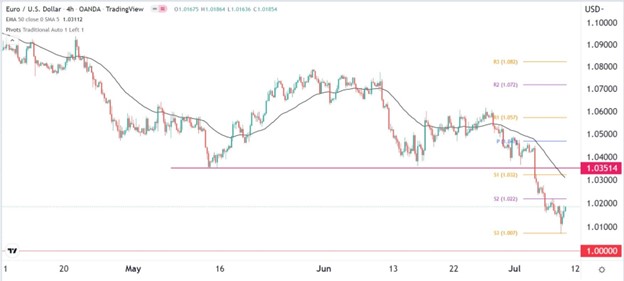Bullish View
- Buy the EUR/USD pair and set a take-profit at 1.0300.
- Add a stop-loss at 1.0100.
- Timeline: 1-2 days.
Bearish View
- Set a sell-stop at 1.0150 and a take-profit at 1.000.
- Add a stop-loss at 1.0250.
The EUR/USD pair moved back slightly after the latest American jobs data that were published on Friday. The pair rose to a high of 1.0195, which was higher than last week’s low of 1.0070. The price is slightly below its parity level of 1.000.
Hawkish FOMC Priced In
The EUR/USD tilted upwards after the United States published strong jobs data on Friday. According to the Bureau of Labor Statistics (BLS), the country’s economy added 372k jobs in June as the economic strength continued.
The unemployment rate remained unchanged at 3.7% while wages continued growing by more than 5%. However, the closely watched participation rate remained under intense pressure in June.
Therefore, investors believe that the Fed will continue rising rates by 0.75% later this month and then signal that it will hike by 0.50% in its September meeting. As such, the upcoming US inflation data will likely not have an impact on the Fed’s decision.
Economists polled by Reuters expect the data to show that the country’s inflation jumped from 8.6% in May to 8.8% in June. Most of this inflation will be because of the soaring food and energy prices. Excluding the two, analysts expect that consumer prices declined from 6.0% to 5.8%. Traders will also focus on the month-on-month numbers.
Meanwhile, the EUR/USD pair is tilting upwards as the euro narrowly avoided moving to parity level. The main concern for euro investors is that the European Central Bank (ECB) will likely struggle hiking interest rates due to the uneven recovery of the bloc. Most countries, including Germany, are struggling as Russia continues lowering its gas deliveries to the region.
The key events to watch from Europe will be the upcoming eurogroup meetings and EU economic outlook by the European Commission.
EUR/USD Forecast
The four-hour chart shows that the EUR/USD pair dropped sharply last week as it approached the parity level. It is now trading ay 1.0185, which is lower than the lowest point last week. The pair remains significantly below the important resistance level at 1.0351, which was the lowest point in May and June of this year.
The pair has also moved below the 25-day and 50-day moving averages. It is also approaching the second support of the standard pivot point. Therefore, the pair will likely continue rising as investors buy the dip, with the next key resistance to watch being at 1.0300. This is part of a break and retest pattern.


